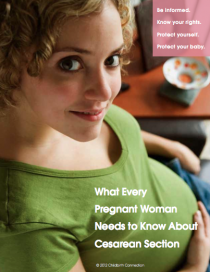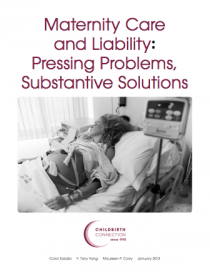January 17, 2013
Maternity Care On the National Agenda - New Opportunities for Educators and Advocates
By: Amy M. Romano, RN,CNM | 0 Comments
Today, Amy Romano, CNM, MSN, Associate Director of Programs for Childbirth Connection (and former Community Manager for this blog) follows up last Thursday's post, Have You Made the Connection with Childbirth Connection? Three Reports You Don't Want to Miss with her professional suggestions for educators and advocates to consider using the data and information contained in these reports and offering your students, clients and patients the consumer materials that accompany them.- Sharon Muza, Community Manager.
 As we begin 2013, it is clear from my vantage point at the Transforming Maternity Care Partnership that the transformation is underway. In Childbirth Connection's nearly century-long history, we've never seen so much political will from leaders, so much passion from grassroots advocates, and so much collaboration among clinicians and other stakeholders. This new landscape presents many new opportunities for educators and advocates.
As we begin 2013, it is clear from my vantage point at the Transforming Maternity Care Partnership that the transformation is underway. In Childbirth Connection's nearly century-long history, we've never seen so much political will from leaders, so much passion from grassroots advocates, and so much collaboration among clinicians and other stakeholders. This new landscape presents many new opportunities for educators and advocates.
One area of maternity care that has garnered increasing attention is the overuse of cesarean section, especially in low-risk women. Last year, the multi-stakeholder Maternity Action Team at the National Priorities Partnership set goals for the U.S. health care system and identified promising strategies to reach these goals. One of the goals was to reduce the cesarean section rate in low-risk women to 15% or less. This work served as the impetus for Childbirth Connection to revisit and update our Cesarean Alert Initiative. We undertook a best evidence review to compare outcomes of cesarean delivery with those of vaginal birth. Based on the results, we also updated and redesigned our consumer booklet, What Every Pregnant Woman Needs to Know About Cesarean Section. These are powerful new tools to help educators and advocates push for safer care, support shared decision making, and inform and empower women.
Two of the biggest obstacles to change have been persistent liability concerns and the current payment system that rewards care that is fragmented and procedure-intensive. Efforts to make maternity care more evidence-based or woman-centered often run up against policies and attitudes rooted in fear of lawsuits or increasing malpractice premiums, or against the reality that clinicians can not get easily reimbursed for doing the right thing. But these barriers are shifting,
Recently the literature has provided example after example of programs that reduced harm and saw rapid and dramatic drops in liability costs as a result. That's right ' one of the best ways to decrease liability costs is to provide safer care. Rigorous quality and safety programs are the most effective prevention strategy among the ten substantive solutions identified in Childbirth Connections new report, Maternity Care and Liability. The report pulls together the best available evidence and holds potential liability solutions up to a framework that addresses the diverse aims of a high-functioning liability system that serves childbearing women and newborns, maternity care clinicians, and payers.
The evidence and analysis show that some of the most widely advocated reforms do not stand up to the framework, while quality improvement programs, shared decision making, and medication safety programs, among other interventions, all have potential to be win-win-win solutions for women and newborns, clinicians, and payers. If we are to find our way out of the intractable situation where liability concerns block progress, we must learn to effectively advocate for such win-win-win solutions. Advocates and educators can better understand these solutions by accessing the 10 fact sheets and other related resources on our Maternity Care and Liability page.
Evidence also shows that improving the quality of care reduces costs to payers. As payment reforms roll out, there will be many more opportunities to realize these cost savings. To predict potential cost savings, however, it is necessary to know how much payers are currently paying for maternity care. Surprising, this information has been largely unavailable, and as a result we have had to settle for using facility charges as a proxy. This is a poor proxy because payers negotiate large discounts, and because charges data do not capture professional fees, lab and ultrasound costs, and other services. Childbirth Connection, along with our partners at Catalyst for Payment Reform and the Center for Healthcare Quality and Payment Reform, recently commissioned the most comprehensive available analysis of maternity care costs. The report, The Cost of Having a Baby in the United States shows wide variation across states, high costs for cesarean deliveries, and rapid growth in costs in the last decade. It also shows the sky-high costs uninsured women must pay ' costs that can easily bankrupt a growing family. Even insured women face significant out-of-pocket costs that have increased nearly four-fold over six years. Fortunately, health care reform legislation has made out-of-pocket costs for maternity care more transparent by requiring a simple cost sample to each person choosing an individual or employer-sponsored health plan.
Educators and advocates have to be able to help women be savvy consumers of health care. That means being informed about their options and also being able to identify and work around barriers to high quality, safe, affordable care. Childbirth Connection produced this trio of reports to provide a well of data and analysis to help all stakeholders work toward a high-quality, high-value maternity care system.
How Childbirth Educators and Consumer Advocates Can Help
- Incorporating the findings of the cesarean best evidence review in teaching and advocacy, and sharing the information widely on Facebook, Twitter, blogs, listservs, and other social media.
- Getting the booklet, What Every Pregnant Women Needs to Know About Cesarean Section into the hands of expectant parents.
- Becoming familiar with the 10 Maternity Care and Liability fact sheets, and sharing them whenever a teachable moment arises.
- Learning more about shared decision making, and incorporating support for high-quality shared decision making into education efforts (a future blog post will focus on this.)
- Advocating for the use of quality improvement toolkits to improve care in hospitals and health systems.
- Talking about health care value ' care that improves quality while reducing costs, including physiologic care to reduce the chance of c-sections.
- Helping women understand their likely maternity-related out-of-pocket costs when they enroll in a new health plan.
- Helping women to understand that, until we reform our payment systems, clinicians and hospitals are rewarded financially and logistically for cesareans and inductions, and to carefully explore whether these forms of care, when recommended, are right for them.
What is the first thing that you are going to do to join this maternity care transformation? Can you share your ideas for using this information in your classroom or with clients or patients. Can you bring others on board to help with this much needed transformation?- SM
Tags
Childbirth education Cesarean Interventions Childbirth Connection Maternity Care Maternity Care Systems Patient Advocacy Amy Romano Healthcare Reform Evidence Based Medicine Maternity Care Quality Maternal Quality Improvement Cesarean Section Professional